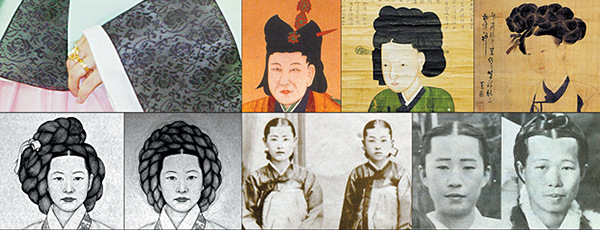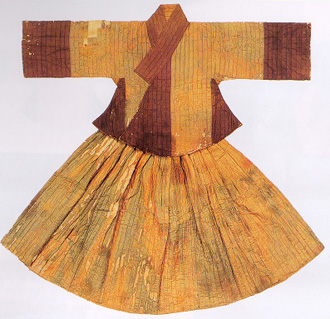Time for a yeongjeong facelift?
Published: 21 Jan. 2013, 19:56

A professor of Korean painting at the Fine Arts College of Chungnam National University, Yun is one of the people who make yeongjeong, or paintings of the deceased.
He has given a face and body to historical figures like Nongae, a 16th century gisaeng (female courtesan) that seduced a Japanese general and jumped off a cliff holding him during the Japanese invasion attempts of Korea; Park Paeng-nyeon, one of the most famous scholars of the Joseon Dynasty (1392-1910); and the Wife of Domi, a woman of the Baekje Kingdom (18 B.C.?A.D. 660) known for her loyalty and love for her husband, even declining an offer from a king to be his woman.
Six of his paintings of historical figures are designated by the government as the “standard” for such work. This means that when portraits or statues are made of those people, or their faces are put on Korean currency or textbooks, they have to be consistent with Yun’s depiction of them.
“It’s a very painstaking, long process,” says Yun. “You gather documents about the figure, do research on the times and people of the times, and seek to show the character and dignity of the figure. It’s art, but also science that has an educational purpose.”
Korea has a policy called “Deliberation on the Standard Yeongjeong,” adopted in 1973. Basically a panel of experts in areas like history, art, clothing appointed by the culture minister would review paintings of the deceased - often done at the request of local governments or clansmen and chosen by them after a contest - and determine whether or not they have what it takes to be a “standard.”
Currently, there are 89 standard yeongjeong in the country.
Although the policy was introduced to prevent the uncontrolled flood of poor-quality portraits of Korea’s historical heroes and ancient sages, the policy has been the center of heated debate among Koreans who argue it’s an anachronistic concept from the 1970s and 1980s. Such a policy for designating a standard, many observers say, is not found in other countries, although the culture of yeongjeong exists, as in the case of portraits of Jesus.
First, critics are questioning if there can be a “government-designated standard for portraits that is in the realm of art.” Secondly, they are questioning if such a policy is necessary since people don’t really follow it anyway. Third, critics point to how a majority of yeongjeong are made by painters who were Japanese collaborators, which diminishes the meaning and status of the paintings.

Yeongjeong requires long hours of research and collaboration with experts in clothes, hair and makeup, as shown in Yun Yeo-whan’s painting of Nongae (top) and materials and notes he gathered (above). Provided by Yun
Incarnation process
“I made sure that despite her young age, she exudes strong determination and class,” Yun says, referring to his yeongjeong of Nongae, who was believed to be 20 years old when she died.
To put a face on Nongae, whose real name is not known but is believed to be from the Sinan Ju clan of Jangsu County, North Jeolla, Yun consulted Jo Yong-jin who is known to a “face expert” in Korea. Jo allegedly studied women of the Sinan Ju clan and came up with 150 characteristics unique to their faces.
For hairstyle, Yun sought assistance from Son Mi-gyeong of the Research Center for Ancient Hairstyles. Son said Nongae must have had gachae - a big, heavy and decorative wig - because she lived before the reign of King Yeongjo. The king banned the wigs after an incident where a woman’s neck broke due to the weight of hers. There had already been criticism of the amount of money women spent on the wigs. The bigger the gachae, the richer the woman and the higher her status.
For clothes, the Research Center for Classical Wardrobe suggested an outfit similar to one discovered from a 1560s tomb in Andong, North Gyeongsang.
And for makeup, Yun used the so-called Jinsuami method that can be found in historical records and emphasizes a wide forehead and crescent brows.
The only thing in Yun’s drawing not based on historical evidence is the rings on her fingers. Legend has it that she clasped her hands wearing the rings so the general couldn’t escape.
Concerning recent debates over the “Deliberation on the Standard Yeongjeong” policy, Yun emphasized that only experts should make the paintings and only experts truly qualified should review them. If that occurs, he said, then the policy has a purpose.
“It’s not an imaginary painting,” he says. “It has to be persuasive and realistic, both for the academia and the public.”

In attempts to find ways to improve the “Deliberation on the Standard Yeongjeong” policy, the Ministry of Culture, Sports and Tourism held a public debate last month.
“Let art be done by the artist,” argued Park Jae-dong, professor of animation at the Korea National University of Arts.
He said there cannot be a government standard in the realm of arts, saying “the Vatican doesn’t have a standard on portraits and statues of the Virgin Mary or Jesus.” In fact, he said, the Virgin Mary wearing hanbok [traditional Korean clothing] by sculptor Oh Chae-hyeon is in the Korean Embassy in Vatican City. He also cited Western-style painter Koo Bon-woong’s (1906-53) portrait of his friend and famous poet Yi Sang (1910-37), which is rather abstract and bears only faint resemblance to Yi’s actual face.
Park recounted how the policy was a political tool in the 1970s. President Park Chung Hee, who earlier had been the first lieutenant of a puppet regime that Japan set up to rule Manchuria, used statues and portraits of Joseon-era Admiral Yi Sun-shin (1545-98), whom Koreans respect for his defeat of Japan, to validate his authority and deflect allegations that he was pro-Japanese, historians say. In 1973, he ordered the government to determine a standard on portraits of Yi and other historical heroes, government record shows.
Another reason people disregard “Deliberation on the Standard Yeongjeong” policy actually has to do with the fact that many painters who drew yeongjeong were Japanese collaborators.
Even Jang Wu-seong, who produced the standard Admiral Yi painting, is believed to be a Japanese collaborator; so is Kim Ki-chang, who painted the standard King Sejong, and Kim Eun-ho who produced the standard image of famous Joseon-era scholar Yulgok Yi Yi (1536-1584).
Ironically, Jang also drew the yeongjeong of Yu Gwan-sun (1902-1920), a teenage girl who died fighting against Japan. A new painting of Yu was made in 2007 by Yun, as the Cheonan government said the painting was based on a prisoner photo of Yu and she was probably swollen due to torture. [Yu is from Cheonan, South Chungcheong.] Other paintings made by Japanese collaborators remain government standards.

The regulation that sets a standard on portraits of historical figures is under criticism. (From top) Government-designated standard portraits of King Sejong; respected artist Sin Saimdang; and teenage freedom fighter girl Yu Gwan-sun. [JoongAng Ilbo]
Other critics also argue that even if there is a standard portrait, portraits and statues end up at least slightly different so it’s meaningless to designate a standard.
For instance, King Sejong is in a shrine in Yeoju, Gyeonggi, as a portrait and as a statue in Deoksugung Palace in central Seoul, Yeouido Park in Yeouido and Gwanghwamun square in downtown Seoul. Critics say they all look different from each other to some degree. The statue in Deoksugung Palace, set up in 1968, was done before the “Deliberation on the Standard Yeongjeong” policy was introduced. Meanwhile, others portray Sejong at a slightly different age and that is why they turned out different even if artists based their works on the standard.
Still, there are advocates of the “Deliberation on the Standard Yeongjeong” policy, or at least those who say that it should be improved, not scrapped.
Jo Yong-jin, one of the members of the panel that reviews paintings, says that the standard yeongjeong is a culture unique to Koreans and a genre of painting in the country. He contends that the problems can be fixed and the policy improved.
“Portraits during the Joseon Dynasty were ‘whole body painting’ that sought to deliver not just superficial appearances, but also the interior of the person, like their nature and hearts,” he says. “It was an independent form of art and the standard yeongjeong [of today] sort of preserves and carries on such paintings.”
Wang Hyeong-yeol, professor of painting at Dankook University, agrees.
“These days, the art scene is seeing the emergence of only a very few professional portrait painters,” he says. ”Once this policy is scrapped, the portrait itself will decline very fast and soon be over-the-hill.”
Wang adds that the policy can be improved and Korea could introduce a system in which professionals can study and educate themselves in this most-Korean of art forms.
By Kim Hyung-eun [hkim@joongang.co.kr]










with the Korea JoongAng Daily
To write comments, please log in to one of the accounts.
Standards Board Policy (0/250자)